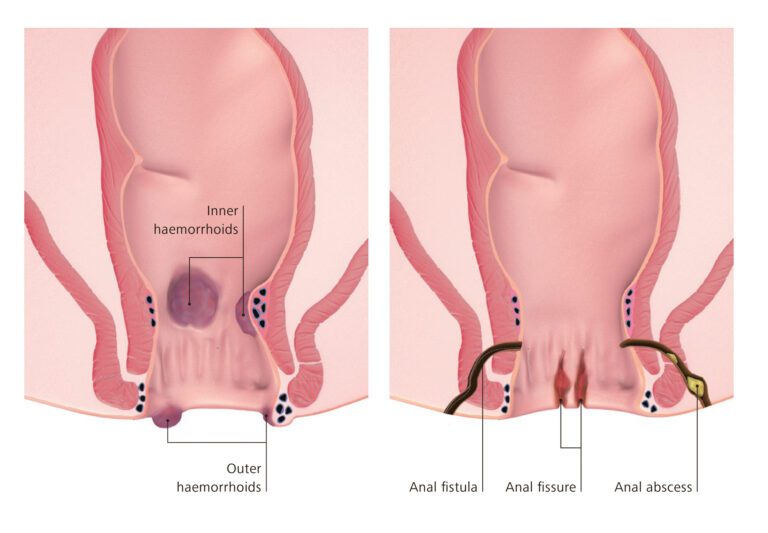
Hemorrhoids and anal fissures are two common rectal conditions that can cause discomfort and pain, especially when they become symptomatic. While they share some similarities, such as rectal bleeding, they are distinct conditions with unique causes and treatment approaches. In this article, we will delve into the differences between hemorrhoids and anal fissures, helping you understand these conditions better.
What Are Hemorrhoids?
Hemorrhoids, also known as piles, are swollen blood vessels located in the rectal and anal area. They can be internal, occurring inside the rectum, or external, located under the skin around the anus. Hemorrhoids is a lifestyle disorder which can result from increased pressure in the rectal veins, often caused by straining during bowel movements, chronic constipation, or prolonged sitting.
Types of Hemorrhoids
1. Internal Hemorrhoids: Located inside the rectum, usually painless, and often accompanied by bleeding during bowel movements.
2. External Hemorrhoids: Found under the skin around the anus, can be painful, itchy, and may bleed.
What Are Anal Fissures?
Anal fissures are small tears or cracks in the lining of the anal canal. They can cause sharp pain and bleeding during and after bowel movements. Anal fissures are typically a result of trauma to the anal canal, often from passing hard or large stools.
Causes of Anal Fissures
– Constipation
– Diarrhea
– Trauma during childbirth
– Anal intercourse
– Inflammatory bowel diseases
Key Differences Between Hemorrhoids and Anal Fissures
Location
Hemorrhoids can be internal or external, while anal fissures are small tears in the lining of the anal canal.
Causes
Hemorrhoids are primarily caused by increased pressure in the rectal veins, while anal fissures result from anal trauma or other conditions like diarrhea.
Symptoms
Hemorrhoid symptoms may include bleeding, itching, and discomfort, while anal fissures typically cause intense pain and bleeding during bowel movements.
Pain Level
Anal fissures are often associated with severe, sharp pain, whereas hemorrhoids are usually less painful and can be itchy or uncomfortable.
Diagnosis and Medical Evaluation
Both conditions can be diagnosed through a physical examination, but further tests such as anoscopy, sigmoidoscopy, or colonoscopy may be necessary to determine the extent of the condition and rule out other problems.
Treatment Options for Hemorrhoids
Lifestyle Changes
1. Eating a high-fiber diet
2. Staying hydrated
3. Avoiding straining during bowel movements
4. Regular exercise
Over-the-Counter Medications
Over-the-counter creams and suppositories can provide relief from hemorrhoid symptoms.
Medical Procedures
1. Sclerotherapy
2. Rubber band ligation
Treatment Options for Anal Fissures
Lifestyle Modifications
1. Consuming a high-fiber diet
2. Drinking plenty of water
3. Avoiding straining during bowel movements
4. Warm baths for pain relief
Medications
– Topical creams and ointments for pain relief
– Nitroglycerin ointment to relax the anal sphincter
Surgery
In severe cases, surgical procedures may be necessary to treat anal fissures.
Prevention Strategies
Hemorrhoids Prevention
1. Maintain a high-fiber diet
2. Stay hydrated
3. Avoid prolonged sitting
4. Exercise regularly
Anal Fissures Prevention
1. Maintain soft, regular bowel movements
2. Avoid straining during bowel movements
3. Practice safe anal intercourse
Living with Hemorrhoids
People with hemorrhoids can manage their condition through lifestyle changes, over-the-counter medications, and, in some cases, medical procedures.
Living with Anal Fissures
Living with anal fissures may involve dietary modifications, medication, and, in severe cases, surgical intervention. Pain relief and proper wound healing are essential during recovery.
When to Seek Medical Help
If you experience rectal bleeding, severe pain, or suspect you have either condition you can consult lady Proctologist at Padma Hospital for proper diagnosis and treatment recommendations.
Conclusion
Understanding the differences between hemorrhoids and anal fissures is essential for accurate diagnosis and treatment. While both conditions can cause discomfort and rectal bleeding, their causes, symptoms, and treatments vary. If you suspect you have either condition, seek Laser Proctologist advice to ensure the right approach to managing and alleviating your discomfort.
